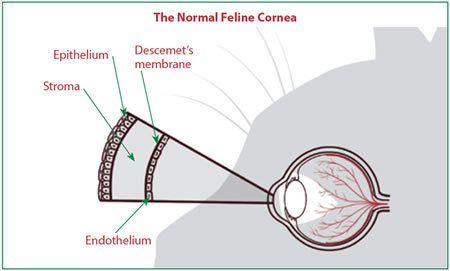The cornea, the clear coating of the eye that admits light, has layers of specialized skin cells, including:

– Epithelium, the outer layer of tissue covering the cornea, keeps foreign material, such as dust, water and bacteria, from entering the eye. It also absorbs oxygen and cell nutrients from tears and distributes them to the rest of the cornea. Its tiny nerve endings make the cornea sensitive to pain when rubbed or scratched.
– Stroma is connective tissue cells composed of water and flattened plates of collagen fibers that provide strength, elasticity and form to the cornea.
– The endothelium, a single layer of cells, mainly keeps the cornea dehydrated to maintain vision.
– Descemets membrane, the basement of the endothelium, consists of transparent tissue – collagen fibers differing from those in the stroma – covering the inner surface of the cornea. Its named after the 18th-century physician Jean Descemet.



